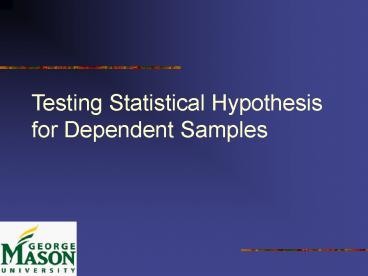Testing Statistical Hypothesis for Dependent Samples - PowerPoint PPT Presentation
1 / 25
Title:
Testing Statistical Hypothesis for Dependent Samples
Description:
Establish the level of significance:a. Determine whether to use a one tail or two tail test ... X2 = Indirect method: the bell component of the stethoscope. 7 ... – PowerPoint PPT presentation
Number of Views:32
Avg rating:3.0/5.0
Title: Testing Statistical Hypothesis for Dependent Samples
1
Testing Statistical Hypothesisfor Dependent
Samples
2
Testing Hypotheses about Two Dependent Means
- Dependent Groups t-test
- Paired Samples t-test
- Correlated Groups t-test
3
Steps in Test of Hypothesis
- Determine the appropriate test
- Establish the level of significancea
- Determine whether to use a one tail or two tail
test - Calculate the test statistic
- Determine the degree of freedom
- Compare computed test statistic against a
tabled/critical value
Same as Before
4
1. Determine the appropriate test
- When means are computed for the same group of
people at two different points in time (e.g.,
before and after intervention) - When subjects in one group are paired to subjects
in the second group on the basis of some
attribute. Examples - Husbands versus wives
- First-born children versus younger siblings
- AIDS patients versus their primary caretakers
5
1. Determine the appropriate test
Continued
- Researchers sometimes deliberately pair-match
subjects in one group with unrelated subjects in
another group to enhance the comparability of the
two groups. - For example, people with lung cancer might be
pair-matched to people without lung cancer on the
basis of age, education, and gender, and then the
smoking behavior of the two groups might be
compared.
6
Example Two Interventions in Same Patients
- Suppose that we wanted to compare direct and
indirect methods of blood pressure measurement in
a sample of trauma patients. Blood pressure
values (mm Hg) are obtained from 10 patients via
both methods - X1 Direct method radial arterial catheter
- X2 Indirect method the bell component of the
stethoscope
7
2. Establish Level of Significance
- a is a predetermined value
- The convention
- a .05
- a .01
- a .001
8
3. Determine Whether to Use a One or Two Tailed
Test
- H0 µD 0
- Ha µD ? 0
Two Tailed Test if no direction is specified
Mean of differences across patients
9
3. Determine Whether to Use a One or Two Tailed
Test
Continued
- H0 µD 0
- Ha µD ? 0
One Tailed Test if direction is specified
10
4. Calculating Test Statistics
How to calculate standard deviation of differences
11
4. Calculating Test Statistics
Continued
Defining Formula Calculating Formula
12
4. Calculating Test Statistics
Continued
13
4. Calculating Test Statistics
Continued
Calculate totals
14
4. Calculating Test Statistics
Continued
15
4. Calculating Test Statistics
Continued
- Calculate t-statistic from average of differences
and standard error of differences
16
5. Determine Degrees of Freedom
- Degrees of freedom, df, is value indicating the
number of independent pieces of information a
sample can provide for purposes of statistical
inference. - Df Sample size Number of parameters estimated
- Df for paired t-test is n minus 1
17
6. Compare the Computed Test Statistic Against a
Tabled Value
- a .05
- Df n-1 9
- ta(df 9) 2.26 Two tailed
- ta(df 9) 1.83 One tailed
- Reject H0 if tc is greater than ta
18
Alternative Approach
- Estimating Standard deviation of differences from
sample standard deviations
19
Variance / Covariance matrix
X1 X2
X1 X2
Variance ofthe first measure
S21 S12
S12 S22
Variance ofthe second measure
Co-variance of Measures of 1 and 2
20
Variance / Covariance matrix
- X1 X2
S21
S22
X1 X2
Standard error of difference can be calculated
from above table
21
Alternative Approach for Calculating standard
Error
Standard error of Differences
Correlation between two measures
22
Correlation Matrix
- Direct Indirect
- Direct Pearson Correlation 1 .996()
- Sum of Squares and
- Cross-products 4496.100 4611.00
- Covariance 499.567 512.333
- N 10 10
- Indirect Pearson Correlation .996() 1
- Sum of Squares and
- Cross-products 4611.00 4768.00
- Covariance 512.333 529.778
- N 10 10
23
Alternative Approach for Calculating standard
Error
Same value as before
24
SPSS output for Paired Sample t-test
Paired Samples Statistics
Paired Samples Correlations
Paired Samples Test
25
Take Home Lesson
- How to compare means of paired dependent samples































